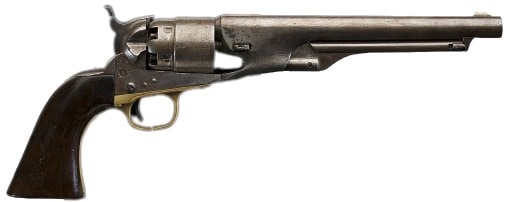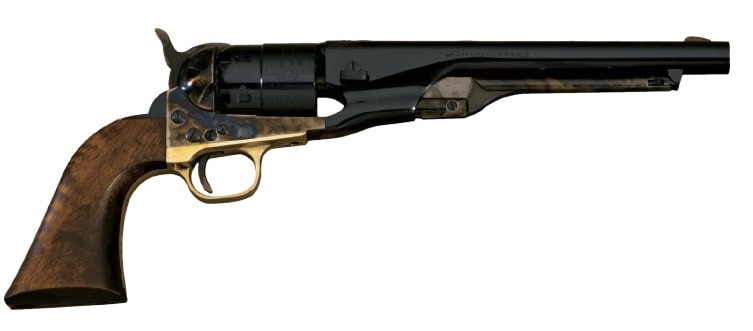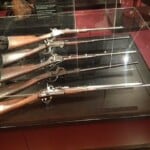
Introduction to the Colt M1860
The Colt 1860 Army revolver is one of the most iconic firearms of the American Civil War era, widely regarded as a masterpiece of mid-19th-century firearms engineering. Designed by Samuel Colt, this revolver combined firepower, reliability, and portability, making it a favorite among Union soldiers, lawmen, and civilians during and after the war. With its .44 caliber percussion system, six-round cylinder, and advanced design features, the M1860 Colt Army played a pivotal role in shaping the evolution of modern handguns.
This definitive guide covers the history, design, ballistics, and combat use of the Colt 1860 Army, including a detailed comparison with the Colt 1851 Navy, its role in the Civil War, post-war modifications, and its lasting impact on firearm development.
Physical Characteristics and Caliber
The Colt 1860 Army revolver was designed as a lighter, more streamlined successor to the Colt Dragoon series, which had been widely used in the Mexican-American War (1846-1848).
Size and Weight
- Overall Length: 14 inches (355 mm)
- Barrel Length: 8 inches (203 mm)
- Weight (Unloaded): 2.5 lbs (1.13 kg)
- Cylinder Capacity: 6 rounds
The 1860 Army utilized an improved rebated cylinder, which allowed for a .44 caliber round while retaining the smaller frame of the 1851 Navy. This engineering advancement, made possible by stronger steel alloys, gave the revolver a significant balance and handling advantage over its predecessors.
Ammunition and Loading System
The Colt 1860 Army revolver was a cap-and-ball percussion firearm, meaning each chamber had to be individually loaded with:
- Black Powder Charge: Typically 30–40 grains of black powder.
- Projectile: Either a .454-inch lead ball or a conical bullet (approximately 138–140 grains).
- Percussion Cap: A small copper cap filled with mercury fulminate, which ignited the powder when struck by the hammer.
Pre-packaged paper or linen cartridges were available, allowing for faster reloading, though many users opted for the more traditional loose powder and ball method.
Performance and Accuracy
The Colt 1860 Army’s rifled barrel provided greater accuracy than earlier smoothbore pistols, making it effective at:
- Effective Combat Range: 50–75 yards
- Maximum Theoretical Range: 200 yards (though impractical in battle)
- Muzzle Velocity: 750–900 feet per second (fps)
- Muzzle Energy: 250–350 foot-pounds (ft-lbs)
Despite its theoretical long-range capability, most combat engagements occurred at close quarters, where the revolver's six-shot cylinder provided a distinct tactical advantage over single-shot pistols.

Colt 1860 Army vs. Colt 1851 Navy
The Colt 1851 Navy and the Colt 1860 Army were among the most widely used handguns of the 19th century, but they had key differences:
1. Caliber and Power
- Colt 1860 Army: .44 caliber, firing a 138–140 grain ball
- Colt 1851 Navy: .36 caliber, firing an 80–86 grain ball
The Army model had significantly more stopping power, making it more effective against horse-mounted cavalry and heavily clothed adversaries.
2. Design and Build
- The Colt 1860 Army featured a round barrel and a fluted cylinder (on early models).
- The Colt 1851 Navy had an octagonal barrel and an unfluted cylinder, often engraved with a naval battle scene.
3. Weight and Balance
- The 1860 Army weighed 2.5 lbs, making it slightly lighter than the 1851 Navy (2.6 lbs) despite having a larger caliber.
- Many shooters felt the 1851 Navy had superior balance, making it more naturally pointable, especially for one-handed shooting.
4. Military Use and Popularity
- The Colt 1851 Navy was more widespread at the start of the Civil War, having been in production since 1850.
- The Colt 1860 Army, introduced in 1860, quickly became the preferred sidearm of the Union cavalry due to its superior firepower.
Both models were heavily used by Union and Confederate soldiers, with many Confederate copies produced by firms such as Griswold & Gunnison.
Use in the American Civil War
The Colt 1860 Army became the primary sidearm for Union forces, with over 200,000 units produced between 1860 and 1873.
Famous Units and Battles
- Carried by Union Cavalry regiments, including those at the battles of:
- Gettysburg (1863)
- Antietam (1862)
- Shiloh (1862)
- Confederate forces also captured and used many 1860 Army revolvers due to shortages of arms.
Post-Civil War Usage and Legacy
After the war, the Colt 1860 Army remained popular among lawmen, frontiersmen, and outlaws, playing a role in the expansion of the American West.
Transition to Metallic Cartridges
With the advent of metallic cartridges, many 1860 Army revolvers were converted using:
- Richards Conversion (1871–1878) – Allowed the use of .44 Colt cartridges.
- Richards-Mason Conversion (1878–1880s) – A more refined factory cartridge conversion.
These conversions extended the usefulness of the 1860 Army well into the late 19th century.
Replacement by the Colt Single Action Army
In 1873, the Colt Single Action Army (Peacemaker) was introduced, firing .45 Colt metallic cartridges. This new design made the 1860 Army obsolete, but many remained in use as converted cartridge revolvers.
Modern Replicas and Collectibility
Today, the Colt 1860 Army is one of the most popular black powder revolvers for shooting enthusiasts and reenactors.
Popular Replicas
- Pietta and Uberti manufacture high-quality modern reproductions for historical enthusiasts.
- Used in Cowboy Action Shooting and Civil War reenactments.
Value and Collectibility
- Original Colt 1860 Army revolvers can fetch $3,000 to $25,000+ depending on condition and historical provenance.
Final Thoughts: A Revolutionary Firearm
The Colt 1860 Army revolver was more than just a sidearm—it was a game-changer in firearms history. Its balance, power, and reliability made it one of the most effective handguns of the 19th century. While eventually replaced by cartridge firearms, its legacy lives on in modern reproductions, historical collections, and pop culture.
This revolver remains a timeless piece of American history, a testament to Samuel Colt’s engineering genius, and a defining weapon of the Civil War era.
Join discussions on the M1860 Colt Army and other Colt firearms here.
If you know of any forums or sites that should be referenced on this listing, please let us know here.
Read the definitive book on this firearm:





